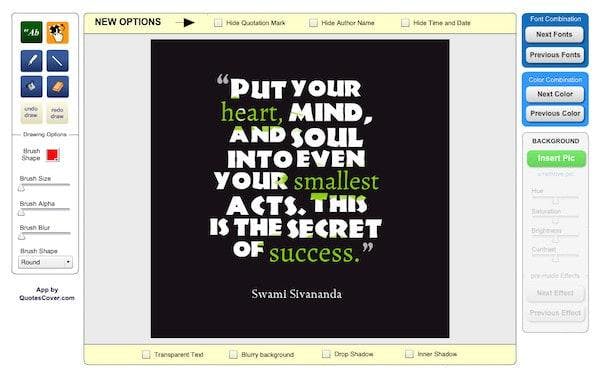It’s no secret. I love visual marketing.
No matter how (or where) we're connected, you'll see bright, bold, and colorful visuals that define my brand.
But it wasn’t always that way. Visual marketing has evolved, and with it, so have online strategies.
As consumer appetite has increased, businesses and brands scramble to create captivating visuals.
Just take a look around at companies like Starbucks, Constant Contact, Marketo, and Nike. They all have one thing in common. Each has created massive appeal through strong visual content.
And they're using social networks such as Instagram, Facebook, Pinterest, and Vine, to tell a striking story.
And the good news? You can too!
Below are steps that you can quickly take to start creating content your audience loves...and wants to spread like wildfire.
PLUS, don't forget to PIN and share the awesome Infographic at the end from QuickSprout.
Why does visual content matter?
In a matter of moments, your audience is making a decision. Will they stop and read or move on? Will they engage with your business or interact with your competition?
Given the speed at which people scan from one piece of content to the next. Having a knock ‘em dead visual presence is critical. Without it, you may lose an opportunity forever.
That's where visual marketing comes in. The right graphic can share your vision, expand the life of a product, sell a service or boost a campaign.
As Andrea Beltrami of The Branded Solopreneur explains,
“Visuals have the power to evoke emotions in a visceral way. They can tell us whole stories in a fraction of the time reading text would take. Visuals are the least inhibited way we have of conveying our message, while simultaneously being the easiest for others to consume.”
And Andrea knows a thing or two about visual marketing. She's built her brand around a streamlined look and feel. From her blog to social media, there's no mistaking her graphics.

As you can see, visuals when done right, are an immediate connection to your brand. They capture attention, drive engagement, and encourage action.
But don’t take my word for it.
The statistics below prove the power behind visual content and why it’s shaping the future of content marketing.
- Over 63% of all social media content today is comprised of images, and approximately 66% of new posts are some form of visual content
- Nearly 54% of internet users have uploaded a video or photo they personally created, and more than 50% of users have re-posted a video or photo they came across online and liked
- Content with suitable images receive over 94% more views (which equates to nearly double the views) than content without images, and the boost is noticeable across all categories and topics
- Tweets with images get 150% more retweets than those without images, and 37% more engagement is experienced when posts on Facebook include photos
- More than 60% of consumers are likely to regard or make contact with a company whose images appear on local searches
Use images to optimize your social media content
Images are the single most important tool when it comes to your social media content optimization.
According to the Adobe 2014 Digital Marketing Optimization survey, more than 80% of respondents point to images as either “very important” or “important” in relation to their marketing optimization on social media.
But how can you use them to optimize your social media content and audience experience?
Here are 9 major forms of visual content you can integrate into your social media posts:
- Attention-grabbing, artistic photography – Think Instagram pictures or stock photos
- Creative video – Consider embedding sites such as YouTube, Wistia and Vimeo right into your posts or share them directly to your social media
- Screenshots – Useful if used right e.g. taking shots of helpful images of workflow or your products/services
- Infographics – Come in handy when you want to convey a meaty or super long message in an easy, bite-sized and informative manner
- Comics – Make a long story short, captivating and humorous with relevant cartoons or comic strips
- Data visualization – Present facts, figures and statistics in a simple and visually stimulating manner through standalone graphs and charts
- Memes – Use trendy memes tailored to fit the context of your updates or posts
- Miscellaneous graphics – Think of diverse images that compliment your content
- Visual note taking – Consider casually designed layouts of ideas
For me, combining each suggestion above works best. It keeps my content fresh and fun, never stagnant.
But what works best for me, may not be the case for you. For example, Chobani makes a delicious Greek yogurt. It's one of my favorite morning treats and a great addition to any meal.
Following Chobani on Instagram gives me a ton of recipe inspiration. But one look at their social media content and it's easy to see that Infographics might not feel on-brand.
The bottom line? Determine what type of visual content feels like the right fit for your business and then identify how you will use it.
Ask yourself:
- How does this image support my goals?
- How will it convert?
- Who will care about it?
- How will it make my audience feel?
Make it a game. With every image you create, make certain you can answer each of those questions.
How to make images your audience will love
Now that you know why visuals are so important, your next step is to make images your audience will love.
There are multiple ways you can use images:
- Create standout social media profiles that are easy to identify. Create branded cover photos that are consistent with your website, blog and offline marketing.
- Speak to your audience's needs. Design social media images that have your target market in mind.
- Design an Infographic like the one below, "The Ultimate Guide to Creating Visually Appealing Content."
- Build thought leadership by taking quotes from your past articles and repurposing them into social media graphics.
- Create a presentation and post it to Slideshare highlighting a popular blog post like the one created by Donna Moritz, founder of Socially Sorted. Oh, and in case you're wondering if this strategy works, just take a look at her views!
Most importantly, once you start to create your images, don’t forget to make them yours. As Social Media Strategist Peg Fitzpatrick explains,
“When you create designs, add your logo and/or website address on your images. Adding this extra bit of flair helps people know that it’s yours, builds your brand recognition, and hopefully deters people from using it without permission.”
Use the right visual marketing tools
Now it's time to make designing your graphics simple!
You can use various online and offline resources to create the ultimate visual content, these include:
Canva
This simple tool is perfect for non-designers to create images with ease. I use it to create simple quote graphics like this one I put together for #InfluencerChat, a weekly Twitter chat I co-host with Ann Tran and Diana Adams.

BeFunky
I love BeFunky! While it's an online resource, it's also an app that allows you to edit and save images to share across any of your social networks.
I use it to edit almost every picture I take.
Skitch
This has been another one of my go-to tools for years.
Skitch, a tool by Evernote, is designed for screenshot optimization and excellent for training and tutorials.

PowerPoint
As a Photoshop user, I've never used PowerPoint to create images, but hear many sing it's praises.
While it's typically thought of as an offline presentation software, it's also become a favorite for many business owners and entrepreneurs.
If you're interested in seeing how to get started, Jenn Herman put together a fantastic tutorial.
Want more tools? Here's a list of the best visual marketing apps to create social media graphics!

Final thoughts
Understanding how to incorporate visual marketing into your social media tactics can give you an edge.
While your competition might have a visual presence in some way, shape or form, most are still struggling with their interpretation
Whether it’s their inconsistency or a lack of a defined strategy, your business can successfully tackle visual marketing, creating differentiation and recognition in an ocean of online noise.
How will you get started? Or if you already have, how is visual marketing supporting your business? I’d love to hear your thoughts in the comments below.
PIN and share the infographic!
Courtesy of: Quick Sprout
About Rebekah Radice
Rebekah Radice, co-founder of BRIL.LA, has traded narcissism for purpose. When not driving growth, you'll find her tricking family into thinking she's Emeril Lagasse - likely covered in marinara. The spotlight was fun, but impact is better. These days she's using 20+ years of brand brilliance for good.
